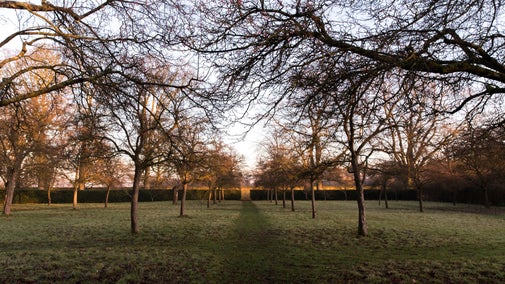
Discover more at Hardwick
Find out when Hardwick is open, how to get here, the things to see and do and more.

Hardwick Hall is the legacy of a woman who had the vision, the wealth and the sheer audacity to commission a house that still takes people’s breath away centuries after it was built. The golden stonework and the sparkling expanse of costly, but oh so fragile glass, looks down on the ruins of the first attempt at building a house fit for a dynasty.
Hardwick Hall is one of the finest Elizabethan buildings in the country. A big claim, but we’re confident you’ll agree.
Full of architectural and artistic delights from Elizabethan embroidery to forties furnishing, a walk through the Hall is always an enjoyable experience.
The Hall is open from 11.00am and last entry is at 2.15pm, giving you time to explore in comfort before the Hall closes at 3.00pm.
Bess of Hardwick, a formidable and talented woman, was responsible for the creation of both Hardwick Hall and Chatsworth House.
Her four marriages led to her becoming the Countess of Shrewsbury and one of the richest women in Elizabethan England.

Bess enlisted the help of Robert Smythson to design Hardwick Hall. This alone was pretty radical, but the building design was also bold, exploring new ideas of the time.
Large glazed windows adorn the Hall and inside the three floors take you on something of a magical mystery tour, with elaborate rooms designed to wow.
Begun in 1590 and completed only seven years later Hardwick is a house that shouted innovation from the same rooftops.
It also proclaimed the owner of the house, Elizabeth Shrewsbury, the Countess of Shrewsbury, with her initials ‘ES’ proudly sitting on the turrets of the house.
Innovations abound at Hardwick, notably that it is one of the first buildings in the country to be ‘designed’ by an ‘architect’; Robert Smythson drew up a plan and a picture of what the building would look like when completed.
Externally, Hardwick is symmetrical, a new idea in building design and appearance that provided a complete contrast to the Old Hall, which it only pre-dates by five years.
Internally, the Countess and her team ‘modified’ Smythson’s plan to ensure that the main staircase rose majestically from the entrance hall in a series of twists and turns to the High Great Chamber on the top floor.
Eight huge windows light this majestic room, where important guests had their meals and were entertained, whether dancing or watching travelling players, listening to music or just playing cards.
The adjacent Long Gallery runs the whole length of the east side of the house, a striking room to display tapestries and pictures, highlighting the wealth and status of the Countess of Shrewsbury.

‘Hardwick Hall, more glass than wall’, is a well-known local saying that highlights one of the key features of Hardwick, namely the exuberant use of an expensive and rare material for houses in 1590s England, namely glass.
Hardwick is home to one of the finest collections of Elizabethan tapestries and embroideries in Europe, including the Gideon tapestries and wall hangings, embroidered by noble women at the Hall.
Almost every room proudly displays tapestry and embroidery work on the walls.
With its collection of fragile textiles, Hardwick has its work cut out when it comes to conservation and it's not just tapestries that make up the collection. Inside you'll find an an extensive collection of textiles, furniture, paintings, ceramics and other decorative objects.
In the old kitchen you can discover more about the life and work of Hardwick's servants. Discover how the Housekeeper, Jane Marriage went from being orphaned at 12, to be a successful and relatively wealthy housekeeper.
Discover why the Head Gardener, Edmund Wilson, was remembered on one occasion as ‘more ducal than the duke’. And uncover why food and drink was brought in all the way from London on the Head Cook’s command.

Find out when Hardwick is open, how to get here, the things to see and do and more.

Read how wealth, power and ambition drove Bess of Hardwick to build her grand design, filled with a treasure trove of fine furnishings that can still be seen at the Hall today.

Discover an internationally-renowned collection of textiles including exquisite tapestries and embroidery and learn about the art of up-cycling, Elizabethan style. Find out more about Bess of Hardwick who largely sourced and collected the textile treasures.

Enjoy serenity in the garden at Hardwick Hall this winter and explore new growth through our Herb Garden and borders.

Historic buildings are a treasure trove of stories, art and collections. Learn more about their past and plan your next visit.

Discover the array of houses and buildings to visit around the Peak District and Derbyshire, from historic mills to ornate Elizabethan wonders.